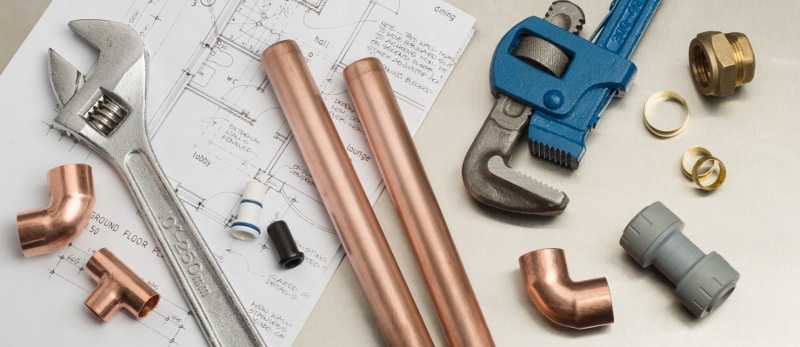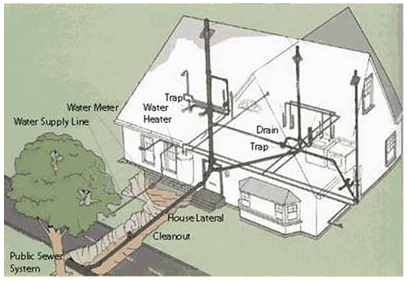Structure of Your Home's Plumbing System: Why It Matters
Structure of Your Home's Plumbing System: Why It Matters
Blog Article
This great article which follows relating to Exploring Your Homes Plumbing Anatomy is exceedingly compelling. Don't miss out on it.

Comprehending just how your home's pipes system functions is essential for every property owner. From providing tidy water for alcohol consumption, food preparation, and showering to safely removing wastewater, a well-maintained plumbing system is essential for your household's health and wellness and convenience. In this detailed overview, we'll discover the detailed network that comprises your home's pipes and deal ideas on upkeep, upgrades, and managing usual concerns.
Intro
Your home's pipes system is greater than simply a network of pipelines; it's a complicated system that guarantees you have access to clean water and effective wastewater removal. Understanding its elements and how they work together can help you prevent costly repairs and ensure everything runs efficiently.
Standard Elements of a Pipes System
Pipelines and Tubing
At the heart of your plumbing system are the pipes and tubes that lug water throughout your home. These can be constructed from numerous products such as copper, PVC, or PEX, each with its advantages in terms of resilience and cost-effectiveness.
Components: Sinks, Toilets, Showers, and so on.
Components like sinks, bathrooms, showers, and bathtubs are where water is used in your house. Recognizing exactly how these fixtures connect to the pipes system aids in identifying issues and planning upgrades.
Shutoffs and Shut-off Factors
Valves control the circulation of water in your plumbing system. Shut-off valves are critical throughout emergencies or when you need to make fixings, permitting you to isolate parts of the system without disrupting water circulation to the whole house.
Water Supply System
Key Water Line
The primary water line connects your home to the metropolitan water system or a personal well. It's where water enters your home and is distributed to various components.
Water Meter and Stress Regulator
The water meter steps your water use, while a stress regulator guarantees that water streams at a safe stress throughout your home's plumbing system, preventing damage to pipelines and fixtures.
Cold Water vs. Warm water Lines
Comprehending the difference between cold water lines, which provide water directly from the major, and warm water lines, which carry warmed water from the water heater, aids in fixing and preparing for upgrades.
Drainage System
Drain Pipes Pipes and Traps
Drain pipelines bring wastewater away from sinks, showers, and bathrooms to the sewer or sewage-disposal tank. Traps stop sewer gases from entering your home and additionally trap particles that could trigger clogs.
Air flow Pipes
Ventilation pipes permit air into the water drainage system, avoiding suction that can slow water drainage and cause catches to vacant. Appropriate air flow is important for keeping the integrity of your pipes system.
Relevance of Appropriate Drain
Making certain correct drainage avoids back-ups and water damages. Regularly cleaning drains pipes and preserving catches can protect against pricey repairs and extend the life of your plumbing system.
Water Heater
Kinds Of Hot Water Heater
Hot water heater can be tankless or standard tank-style. Tankless heating systems heat water on demand, while storage tanks save heated water for instant usage.
Updating Your Pipes System
Factors for Updating
Updating to water-efficient components or changing old pipelines can boost water top quality, reduce water expenses, and enhance the value of your home.
Modern Plumbing Technologies and Their Benefits
Check out innovations like wise leak detectors, water-saving bathrooms, and energy-efficient water heaters that can save money and decrease environmental impact.
Cost Considerations and ROI
Calculate the upfront costs versus lasting cost savings when taking into consideration pipes upgrades. Several upgrades pay for themselves through decreased utility expenses and fewer repair services.
Exactly How Water Heaters Attach to the Pipes System
Recognizing just how hot water heater connect to both the cold water supply and warm water circulation lines helps in diagnosing concerns like not enough warm water or leaks.
Maintenance Tips for Water Heaters
Regularly purging your hot water heater to eliminate sediment, checking the temperature level setups, and examining for leaks can expand its life-span and enhance energy effectiveness.
Common Pipes Issues
Leakages and Their Causes
Leakages can happen due to maturing pipes, loose installations, or high water stress. Dealing with leaks without delay stops water damage and mold and mildew development.
Obstructions and Obstructions
Clogs in drains pipes and toilets are usually triggered by flushing non-flushable things or an accumulation of grease and hair. Making use of drain screens and bearing in mind what decreases your drains pipes can stop clogs.
Indicators of Plumbing Troubles to Look For
Low water stress, slow drains pipes, foul odors, or uncommonly high water bills are indications of potential pipes problems that need to be dealt with without delay.
Plumbing Upkeep Tips
Routine Examinations and Checks
Arrange yearly plumbing examinations to catch concerns early. Try to find indicators of leaks, rust, or mineral buildup in faucets and showerheads.
Do It Yourself Maintenance Tasks
Basic tasks like cleansing faucet aerators, checking for commode leaks making use of color tablets, or protecting subjected pipelines in cold climates can avoid major pipes concerns.
When to Call a Specialist Plumbing Professional
Know when a plumbing concern requires expert experience. Attempting complicated fixings without proper understanding can result in even more damage and higher repair service prices.
Tips for Decreasing Water Use
Straightforward practices like taking care of leakages immediately, taking much shorter showers, and running complete lots of washing and dishes can conserve water and lower your utility bills.
Eco-Friendly Pipes Options
Consider sustainable pipes products like bamboo for flooring, which is durable and environmentally friendly, or recycled glass for counter tops.
Emergency situation Readiness
Actions to Take Throughout a Pipes Emergency situation
Know where your shut-off shutoffs lie and just how to switch off the water in case of a ruptured pipeline or significant leakage.
Value of Having Emergency Situation Get In Touches With Useful
Keep contact information for local plumbers or emergency situation solutions easily available for quick response throughout a pipes dilemma.
Environmental Impact and Conservation
Water-Saving Fixtures and Appliances
Installing low-flow taps, showerheads, and commodes can substantially minimize water usage without sacrificing performance.
Do It Yourself Emergency Situation Fixes (When Suitable).
Short-term fixes like using air duct tape to spot a leaking pipe or placing a container under a leaking faucet can decrease damages till a specialist plumbing professional gets here.
Verdict.
Comprehending the anatomy of your home's plumbing system empowers you to maintain it properly, conserving money and time on repair services. By complying with routine maintenance routines and remaining educated concerning contemporary plumbing technologies, you can ensure your pipes system runs effectively for many years to come.
Understanding Your Home Plumbing System: A Comprehensive Guide
Plumbing System: The Lifeline of Your Home
At its core, the plumbing system is designed to perform two primary functions: bring fresh water into your home and remove wastewater. The system is a network of pipes, fixtures, and other components that transport water and sewage. Residential plumbing systems include potable water supply lines, drain-waste-vent (DWV) systems, and various plumbing fixtures that make water use in daily tasks possible.
Key Components:
Water Supply: This part of your plumbing system brings municipal water into your home, passing through the main water supply line. It s responsible for supplying all water needs, from drinking to bathing.
Drainage System: It carries waste and water away from your home to the sewer or septic system. This system includes all the piping within your home that leads to external sewage or septic systems.
Vent System: An essential yet often overlooked component, the vent system allows sewer gases to escape and lets air into the drainpipes, ensuring water and waste move correctly through the system.
Fixture: More Than Just Taps and Toilets
Plumbing fixtures are the most interactive parts of the plumbing system, including faucets, showers, toilets, and sinks. Each fixture is connected to the plumbing system and plays a role in either the delivery of freshwater or the disposal of waste and wastewater.
Types of Fixtures:
Faucets and Sinks: Used for washing hands, dishes, and other daily water needs. Toilets: Dispose of human waste through the sewage system. Bathtubs and Showers: Provide bathing facilities, requiring both hot and cold water supply. Water Supply: The Source of Life
The water supply system is a critical component, ensuring that potable water is available throughout your home for various uses, including drinking, cooking, and cleaning. This system consists of pipes that distribute water to different parts of the house, controlled by valves to regulate the water flow.
Types of Plumbing: Materials and Methods
Various types of plumbing systems and materials are used in residential settings, each with its advantages and applications. From copper and PVC pipes for water supply to cast iron and ABS for drainage, the choice of materials can impact the longevity and efficiency of your plumbing system.
https://intownplumbingtx.com/articles/home-plumbing-system-guide/

I am very focused on Plumbing Installation 101: All You Need to Know and I really hope you enjoyed reading my blog post. Are you aware of someone else who is very much interested in Exploring Your Homes Plumbing Anatomy? Feel free to promote it. Thank-you for taking the time to read it.
Book A Service Call Report this page